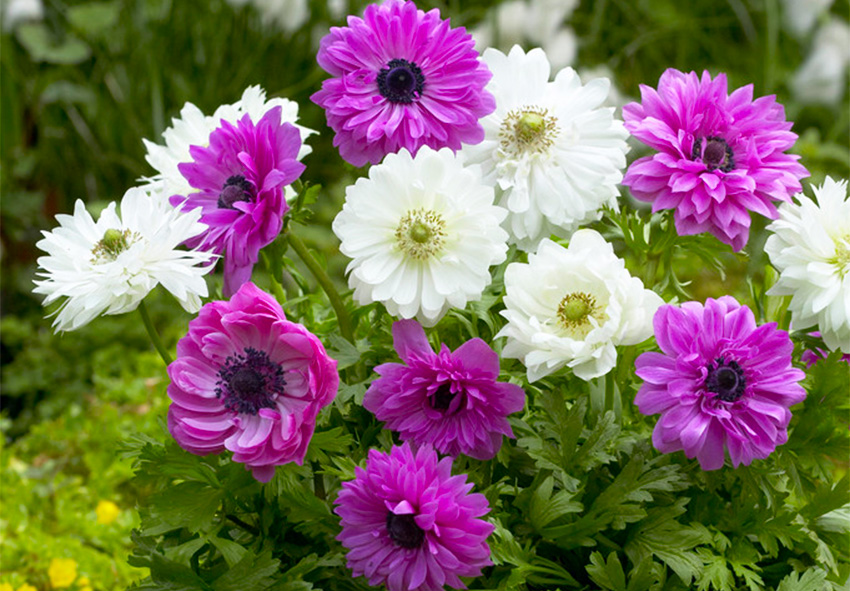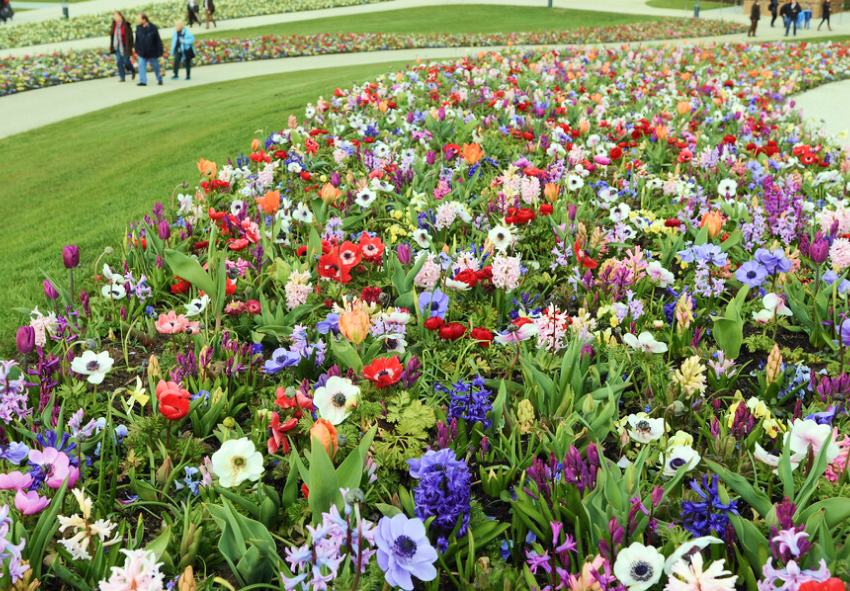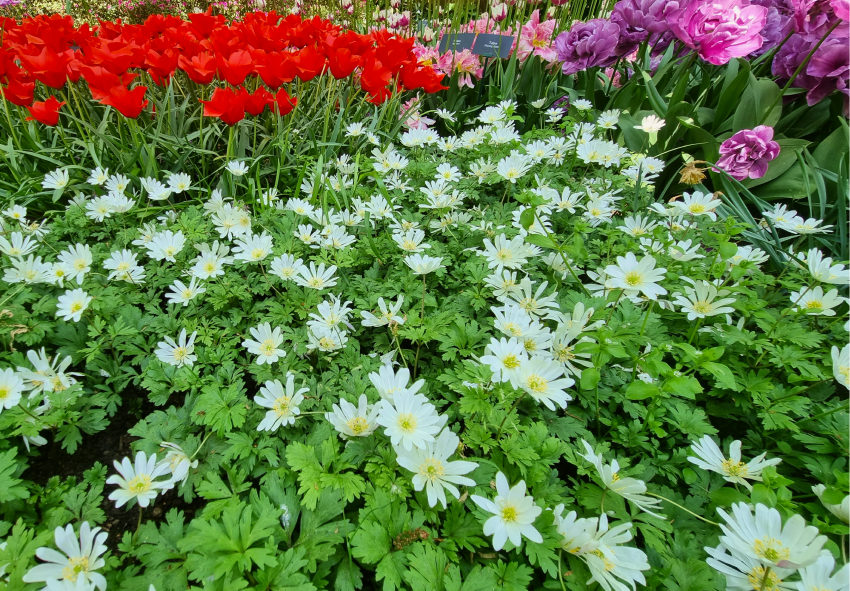Anemones are versatile and charming plants that bring seasonal color, delicate texture, and effortless elegance to gardens. With their wide range of varieties and bloom times, they are an ideal choice for creative garden design. This guide will show you how to integrate anemones into borders, flower beds, and mixed plantings for stunning results. Our gardening blog is a perfect place to find all the information you need!
Understanding Anemones and Their Garden Potential

Anemones are graceful, versatile perennials that can elevate almost any garden space. With a wide range of species offering different bloom times, colors, and growth habits, they’re adaptable to various design styles. Before incorporating them into your landscape, it’s helpful to understand what makes them so valuable in garden planning.
Types of Anemones for Garden Use
There are several types of anemones to consider for your garden. Each type has its own bloom time and growth habit, giving you design flexibility throughout the seasons:
- Anemone blanda (Grecian Windflower): A low-growing, early-spring bloomer with daisy-like flowers in shades of blue, pink, or white. Ideal for naturalizing under trees or in rock gardens.
- Anemone coronaria (Poppy Anemone): Known for its vibrant, poppy-like flowers in bold colors like red, purple, and white. Often grown from tubers, it’s perfect for spring displays and cut flower gardens.
- Anemone hupehensis (Japanese Anemone): A late-summer to fall bloomer with graceful stems and soft pink or white flowers. Excellent for borders and woodland-style gardens.
- Anemone nemorosa (Wood Anemone): A shade-loving spring bloomer that spreads gently through woodlands and shady borders. Features delicate white or pale pink flowers.
- Anemone × hybrida (Hybrid Anemone): A cross between Japanese and other species, offering larger blooms and more robust growth. Great for mixed borders and late-season interest.
Key Features That Make Anemones Ideal for Design
Anemones are valued for their airy blooms, graceful stems, and lush green foliage. Many are deer-resistant and tolerate partial shade, making them adaptable to different garden areas. They work beautifully in naturalistic, cottage-style, or even more formal landscape designs.
Designing with Anemones in Flower Beds
Flower beds offer a perfect canvas to showcase the beauty of anemones. Their soft blooms and varied heights make them ideal for layered planting schemes. Whether you’re filling gaps or creating a focal point, anemones bring elegance and movement to your beds.
Creating Layered Flower Beds
Layering anemones with plants of varying heights creates depth and visual interest. Place taller plants like delphiniums or foxgloves in the back, mid-sized anemones in the middle, and shorter perennials or groundcovers at the front. This design technique allows for a continuous floral display from early spring through fall.
Best Anemone Varieties for Beds
For standout anemone flower beds, consider varieties like Anemone coronaria ‘De Caen’ for bright early color, or Anemone ‘Honorine Jobert’ for elegant white fall blooms. These selections offer long-lasting color and blend well with other perennials. Choose colors that complement or contrast with neighboring plants for maximum effect. Look for more anemone varieties in our full guide for anemones.
Using Anemones as Border Plants

Anemones can define pathways, soften edges, and add seasonal color along garden borders. Their upright growth and long blooming period make them a favorite for edge planting. With the right varieties, they enhance both formal and informal garden layouts.
Placing Anemones Along Edges and Walkways
Anemones make excellent border plants due to their tidy growth and long blooming periods. Plant them along paths, fences, or garden edges to create a soft, flowing border. Their movement in the breeze adds a dynamic, natural element to garden walkways.
Border-Friendly Anemone Varieties
Compact varieties such as Anemone blanda or Anemone ‘Pamina’ work beautifully along borders. These types offer low-growing foliage and long-lasting flowers without overpowering other plants. Choose varieties that bloom at different times to ensure seasonal interest along the entire border.
Companion Planting with Anemones
Anemones pair beautifully with a wide range of perennials and bulbs. Choosing the right companions can extend bloom time, improve visual harmony, and support plant health. Smart pairing also helps reduce pest pressure and makes garden maintenance easier.
Plants That Pair Well with Anemones
Anemone companion plants can include those which bring together complementary textures and staggered bloom times, like:
- Hostas: Their broad, textured foliage provides a striking contrast to the delicate blooms of anemones, especially in shaded or partially shaded areas.
- Ferns: Ferns complement anemones beautifully in woodland or naturalistic gardens, adding lush greenery and soft movement.
- Tulips: Pair early-blooming anemones with tulips for a bold and colorful spring display. They thrive in similar well-drained soil and sunny spots.
- Astilbes: Astilbes bloom in early to mid-summer and love similar moisture-rich soil, creating a seamless transition from spring to summer color.
- Sedum (Stonecrop): For fall-blooming anemones, sedum offers late-season structure and interest. Their fleshy leaves and pink blooms contrast nicely with anemone’s airy flowers.
Avoiding Competition and Overcrowding
While anemones are not overly aggressive, they need room to thrive. Avoid planting them too closely to dense or spreading plants that may compete for moisture and nutrients. Leave enough space for air circulation to reduce the risk of mildew or root rot.
Seasonal Garden Design with Anemones
Different anemone species bloom in spring, summer, or fall, allowing for year-round planning. You can create seasonal themes by combining them with plants that shine at the same time. This approach keeps your garden colorful and interesting across multiple months.
- Spring and Summer Themes
In spring, Anemone blanda and Anemone coronaria bring fresh color when few other perennials have emerged. Combine them with crocuses, hyacinths, and early daffodils for a vibrant seasonal theme. In summer, mix with ornamental grasses or daylilies for a soft, flowing look.
- Fall and Late Season Interest
Japanese anemones shine in late summer and fall when many plants are fading. Pair them with asters, sedums, and ornamental grasses to maintain color and structure. These late bloomers help extend your garden’s interest well into autumn.
Anemones in Different Garden Styles

Whether your garden is modern, rustic, or somewhere in between, anemones can adapt to your aesthetic. Their form and colors work well in structured beds or naturalistic plantings. With thoughtful placement, they become a seamless part of any design style.
Cottage Garden Charm
Anemones bring romantic softness to cottage gardens with their informal shape and pastel hues. Combine them with hollyhocks, campanulas, and roses for a charming, traditional effect. Their natural look complements the unstructured feel of cottage landscapes.
Modern and Minimalist Layouts
In more structured designs, use anemones in monochrome palettes or planted en masse for bold impact. White anemones, like ‘Honorine Jobert’, add elegance to minimalist settings. Pair them with ornamental alliums or boxwood hedging for a clean, contemporary feel.
Common Design Mistakes to Avoid
Even a beautiful plant like anemone can struggle if planted in the wrong conditions. Avoiding common errors helps ensure they thrive and contribute to the garden as intended. A few small adjustments can make a big difference in long-term success:
- Overcrowding Beds or Borders: Anemones may spread slowly over time, but planting them too tightly can lead to poor airflow and disease. Avoid placing them too close to taller, spreading perennials. Proper spacing ensures healthy growth and a balanced garden composition.
- Ignoring Light and Soil Needs: While many anemones tolerate part shade, some types require full sun to bloom properly. Ensure the chosen location matches the needs of the variety. Also, prioritize rich, well-drained soil to support robust root systems.
Final Design Tips for Success
Before planting, lay out your design with potted plants to visualize the arrangement. Think about succession planting by combining early and late-blooming anemones for season-long impact. Maintain your design with occasional division, proper mulching, and deadheading for best results.
Frequently Asked Questions (FAQs) about Anemone Garden Design
1. Do anemones come back every year?
Most anemones are perennials and return each year if properly cared for. Some, like Anemone coronaria, are grown from tubers and may require lifting in cold climates. With the right conditions, they naturalize and even multiply over time.
2. How do I stop anemones from spreading too much?
While most anemones are not invasive, some like Japanese anemones can slowly spread. To control them, divide clumps every few years and monitor their spread. Creating root barriers or planting in containers can also help manage growth.
3. Are anemones good for pollinators?
Yes, anemones attract bees and other pollinators, especially during early and late blooming seasons. Their open-faced flowers are accessible to many beneficial insects. Including them in your garden supports biodiversity and a healthy ecosystem.
4. Can I order anemones bulbs from your online store?
We’re pleased to offer Anemones for purchase through our online store Dutch-bulbs.com. Simply browse our store, choose your favorite Anemone varieties, and follow the easy ordering process to have them delivered to your doorstep, ready for planting.
5. Can anemones grow in full sun?
Yes, many anemone varieties grow well in full sun, especially Anemone coronaria. However, some types, like Japanese anemones, prefer part shade. Matching the light needs of each variety ensures healthy plants and abundant blooms.
Published: 09.05.2025
